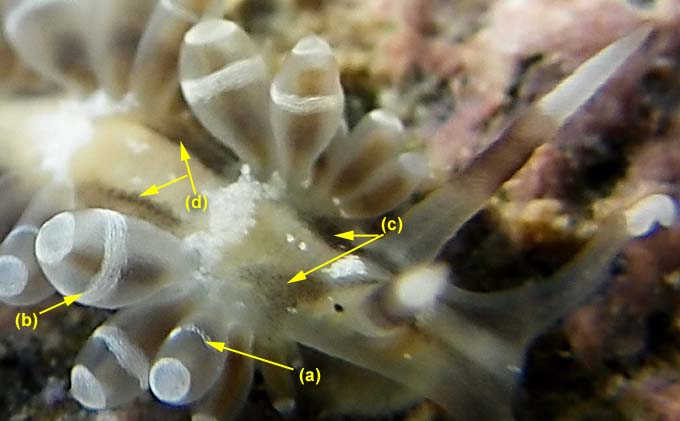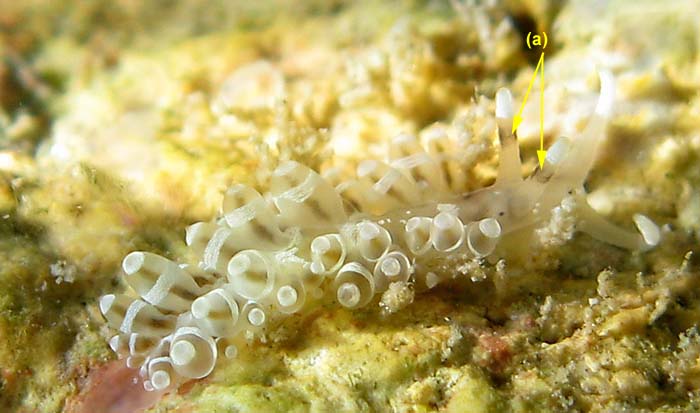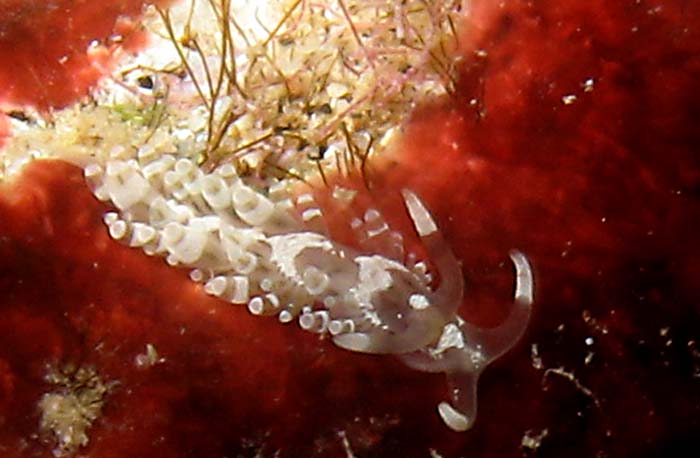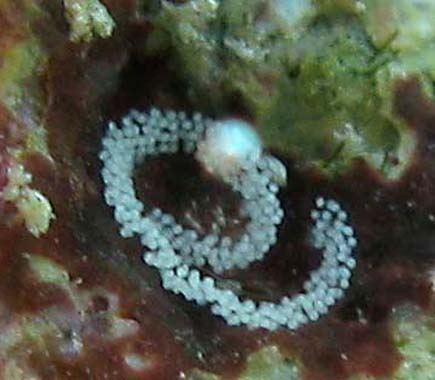This species has been observed on Reunion and Mayotte Islands
Small translucent aeolid with scattered white marks on head and body. Cerata have two broad white bands, one just below the tip and another about halfway down. The oral tentacles and rhinophores are white tipped with a blackish band below the white |

|
|
| Showing species characteristics... | Photo Eva Fontaine Mayotte, "Gombé Ndroumé" less 1 m, 21 December 2011, size : 10 mm |
|
Remarks :
Identification confirmed by Nathalie Yonow
Synonymous : (according Worms)
- No other name
Bibliographic data :
There are scattered opaque white spots (particularly aggregated around the bases of the cerata) over the head and back, but not on sides and papillae.
A U-shaped black to purplish brown line on the head. A black to purplish brown trapezoid marking between the bases of the rhinophores. The dorso-lateral margins behind rhinophores and between branchial rows are each indicated by a black to purplish brown longitudinal band.
The general tegument of body yellowish white, the back more intensively yellowish due to the viscera, the sole colourless.
General colour of diverticulum yellowish brown; on the bulbous portion a local accumulation of melanin pigment granules is marked in the lining epithelium of the diverticulum
Cephalic tentacles slender, opaque white above, each one having a black to brownish purple longitudinal band on the lower half
Rhinophores shorter and simple, opaque white above, yellow tinted below, and each is banded with black to brownish purple in about its half way
The cerata are arranged in about five clusters. The opaque white lower ring can very from a faint narrow line to a broad ring equal in width to the upper ring
The foot is broad. Anteriorly its corners are rounded and enlarged.
Baba (1966) described the species from a single specimen collected from Seto, Kii, Japan on 21 December 1964.
References :
Bill Rudman Seaslug site : Sea Slug Forum : Herviella albida
Nudipixel Herviella albida
Publications :
Baba, K (1960): The genus Herviella and a new species, H. affinis , from Japan (Nudibranchia - Eolidacea). Publications of the Seto Marine Biological Laboratory 8(2) : 303-305.
Baba, K (1966) Record of Herviella albida n. sp. from Seto, Kii, Japan (Nudibranchia - Eolidoidea). Publications of the Seto Marine Biological Laboratory 13(5) : 361-363, Pl.15.
Burn, R F (1967) Revision of the genus Herviella (Opisthobranchia: Eolidacea). Malacologia 6(1-2) : 223-230.
Marcus, Er., & Burch, J.B. (1965) Marine euthyneuran Gastropoda from Eniwetok Atoll, western Pacific. Malacologia, 3(2) : 235-262.
Other photos of Herviella albida :
 |
Eva Fontaine Mayotte, "Gombé Ndroumé" less 1 m, 21 December 2011, size : 10 mm On the cerata, the opaque white lower ring can very from a faint narrow line (a) to a broad ring (b) equal in width to the upper ring The dorso-lateral margins behind rhinophores (c) and between branchial rows (d) are each indicated by a black to purplish brown longitudinal band. |
Christophe Cadet Reunion, L'Ermitage lagoon, less 1 m, 2 February 2012, size : 5-6 mm In the specimen only the rhinophores are white have a blackish band (a) below the white. The blackish band aren't obseve on the oral tentacles. |
 |
 |
Philibert Bidgrain Mayotte,Tanaraki, less 1 m, 2 January 2012, size : 10 mm Two specimens under the same dead coral.
|
Eva Fontaine Reunion, Ravine des poux, Saint Leu, less 1 m, 17 March 2010, size : 12 mm
There are scattered opaque white spots (particularly aggregated around the bases of the cerata) over the head and back, but not on sides and papillae. |
 |
 |
Christophe Cadet Reunion, Saint gilles lagoon, less 1 m, February to March 2012 Two differents observations on differents site under rocks, and always the same spawn just near Herviella albida ... Hazard or its spawn? We need to confirm this observation...
|
More photos from Indian Ocean
Reunion, two Herviella albida, at Saint Gilles, by Philibert Bidgrain
